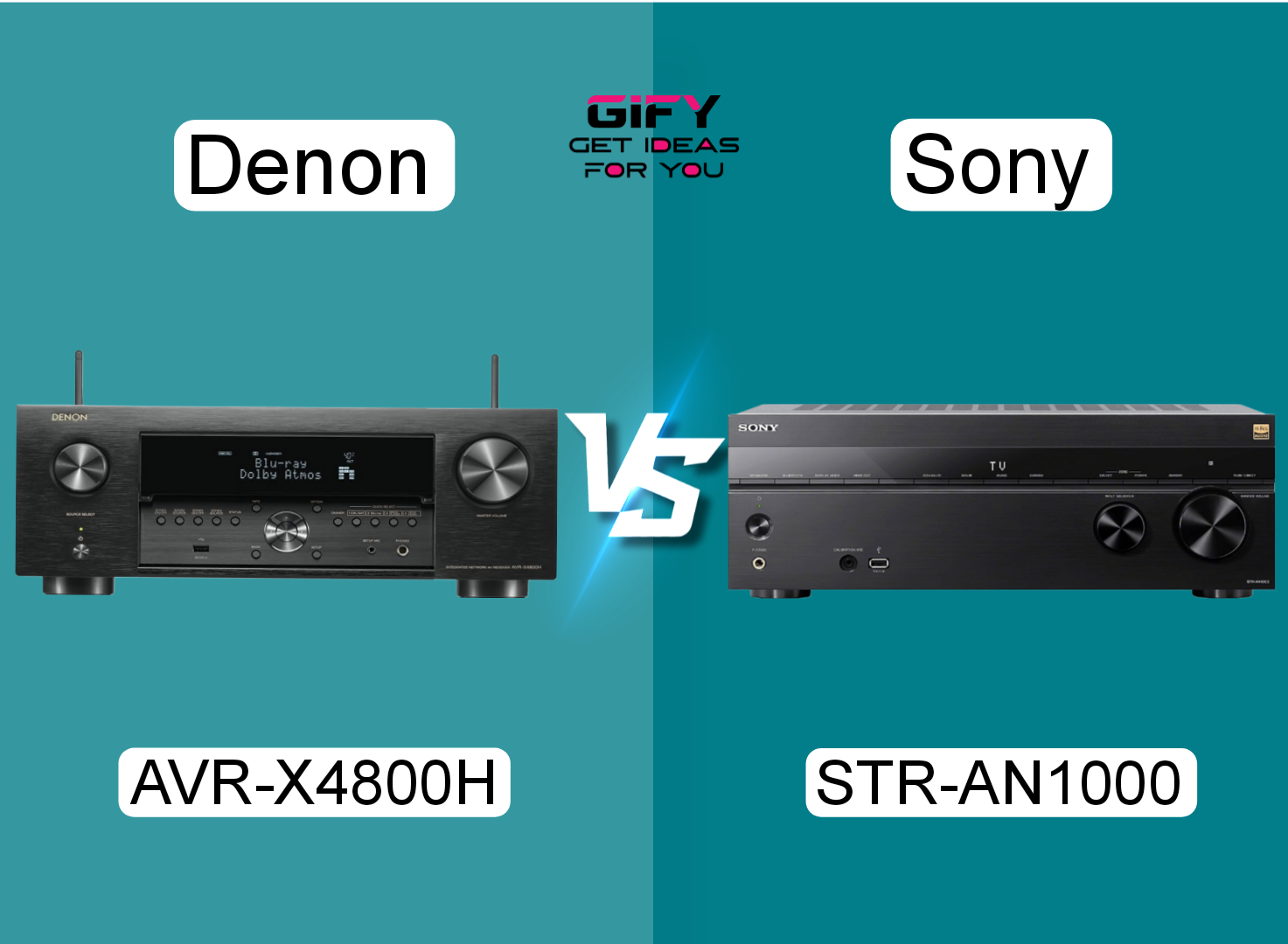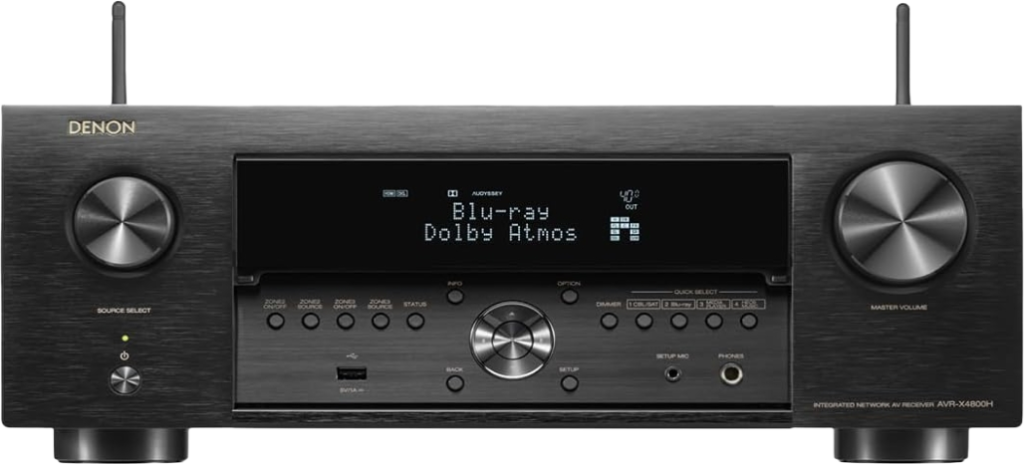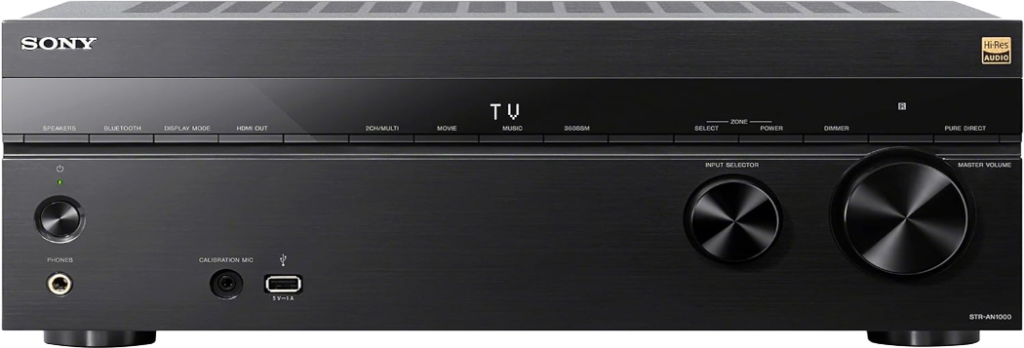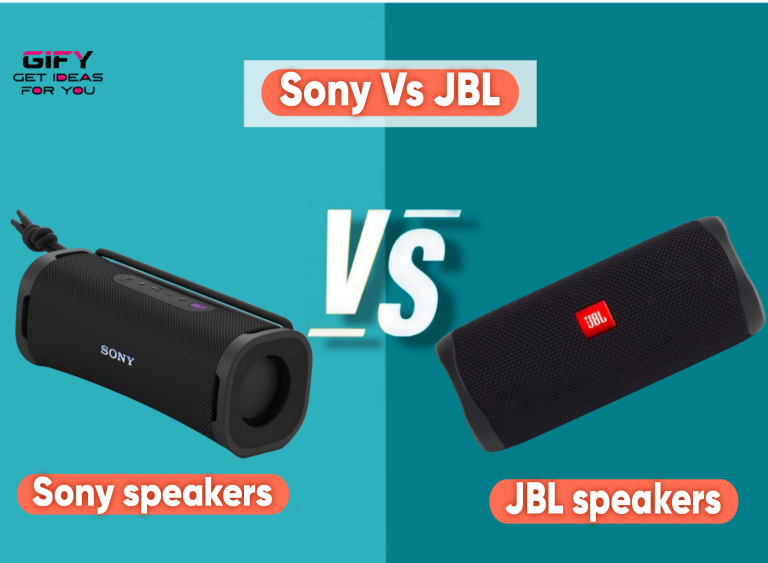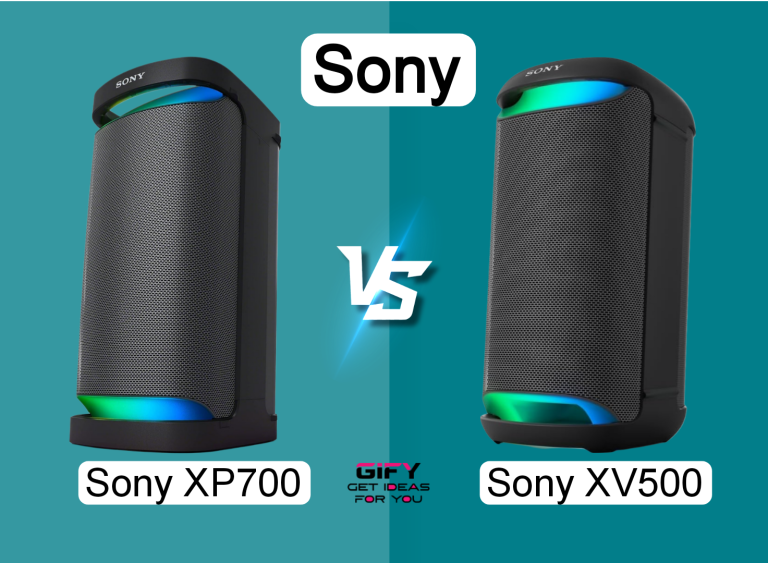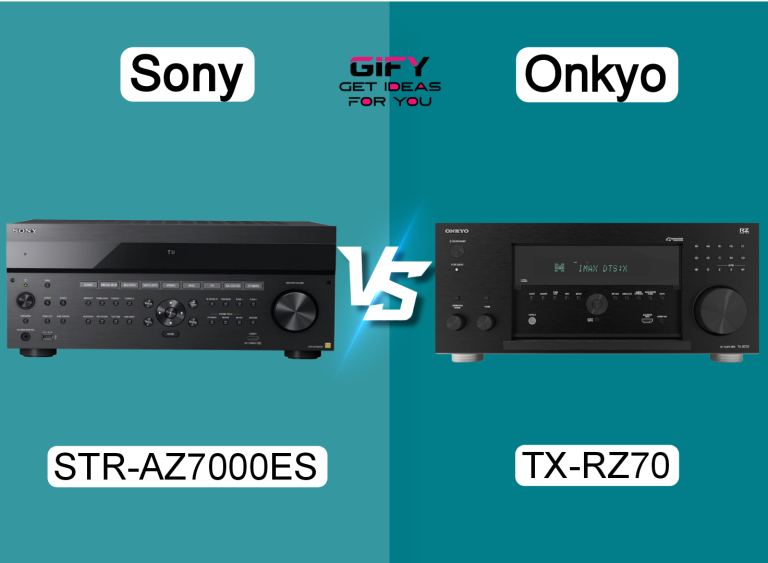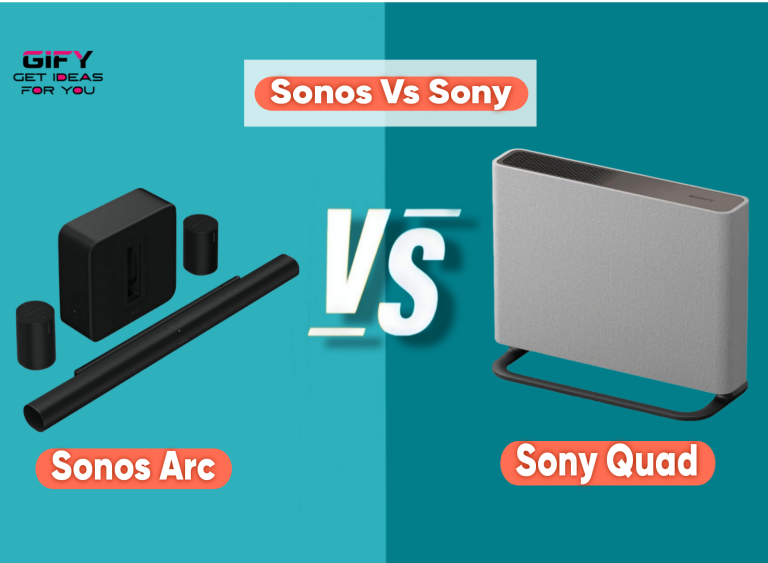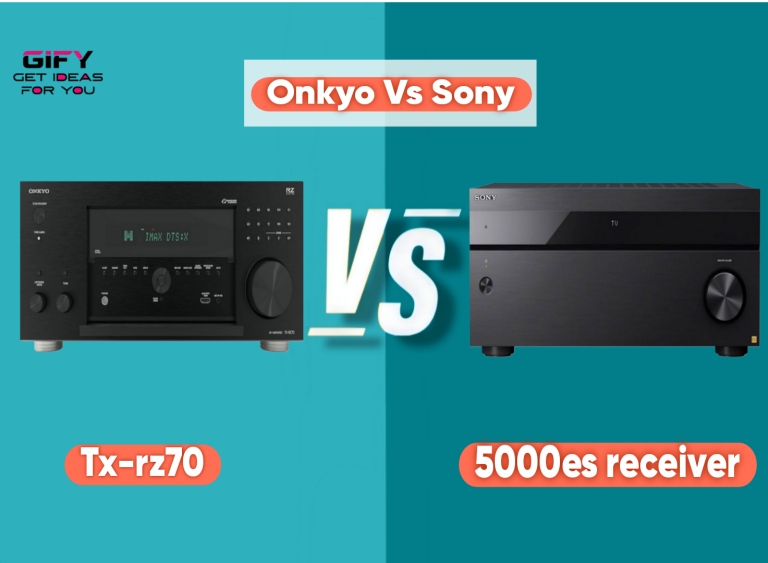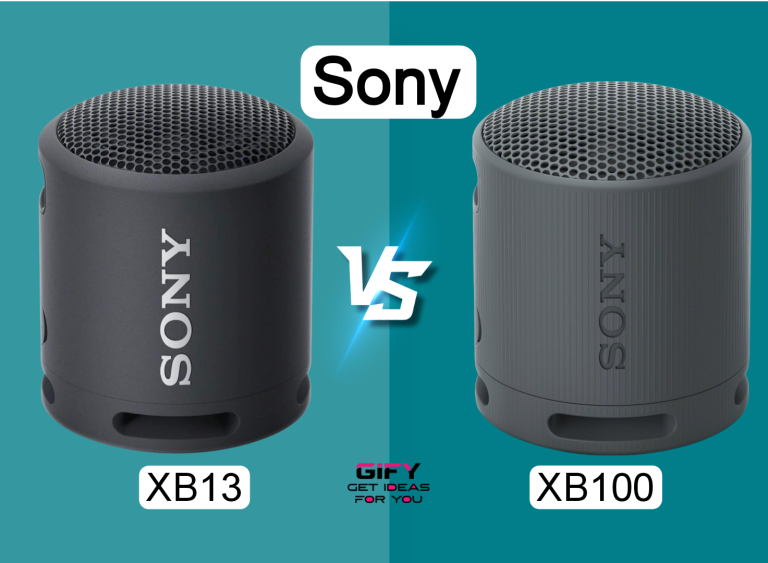The Denon AVRX4800H vs Sony STRAN1000 comparison reveals how two of the most advanced home theater receivers perform in real-world settings. Both models bring immersive 3D sound, 8K video capability, and
smart streaming support, but each delivers a distinct experience that suits different users. This in-depth comparison explores how they differ in power, connectivity, room calibration, and sound quality.
Choosing the right AV receiver can completely transform your home theater setup. The Denon AVR-X4800H is known for its 9.4-channel power and audiophile-grade engineering, while the Sony STR-AN1000 delivers exceptional 7.2-
channel precision with cutting-edge calibration and seamless smart home integration. Each receiver offers premium features designed for immersive sound and video performance.
This guide breaks down all the key aspects—from multi-room capability to build quality—so you can decide which receiver matches your entertainment goals.
Whether you want to upgrade your 4K/8K home cinema or create a dynamic multi-zone setup, understanding the strengths of each model helps you make an informed decision.
By the end of this detailed denon avrx4800h vs sony avr comparison, you’ll know which one fits your budget, room size, and sound expectations best. Let’s dive into how these two powerful AVRs stack up against each other in performance, design, and everyday usability.
Denon AVR-X4800H – Home Theater Stereo Receivers
The Denon AVR-X4800H is designed for enthusiasts who demand cinematic sound and advanced connectivity. With 9.4 channels delivering 125 watts per channel,
this receiver powers large rooms effortlessly. It supports the latest 8K video pass-through and premium 3D audio formats, giving you the kind of immersion you’d expect from a professional theater system.
Detailed Overview
The AVR-X4800H offers a perfect balance of performance and versatility. It includes 10 HDMI ports (7 inputs and 3 outputs), ensuring full compatibility with the latest gaming consoles, Blu-ray players, and 8K televisions.
Each HDMI input supports 8K/60Hz and 4K/120Hz signals with HDCP 2.3 and eARC support, allowing smooth video transmission and lossless audio return from compatible displays.
This receiver shines with its audio technology. Featuring Dolby Atmos, DTS:X Pro, IMAX Enhanced, and Auro 3D, it recreates every sound detail with realistic depth.
Dolby Height Virtualization and DTS Virtual:X simulate overhead channels even without ceiling speakers, delivering an enveloping experience for every listener.
What Is Good
The AVR-X4800H stands out for its superior channel processing. With 9 amplified channels and 4 independent subwoofer outputs, it can drive complex surround
configurations without strain. The built-in HEOS system allows wireless streaming from Pandora, Spotify, TIDAL, and more, extending music across multiple rooms with perfect synchronization.
Denon’s renowned build quality ensures longevity. The internal components are engineered for clean signal flow, resulting in crisp highs, rich mids, and powerful bass response. The 125W-per-channel output easily fills larger rooms with balanced sound at both low and high volumes.
What Is Bad
While feature-rich, the Denon AVR-X4800H can be intimidating for beginners. Its setup process is detailed and may take time for users unfamiliar with home theater configurations. The receiver is also bulkier compared to Sony’s more compact design, which might limit placement options in smaller media centers.
Additionally, the price tag reflects its premium nature. For smaller rooms or casual listeners, many of its advanced features may go underused, making it better suited for dedicated home theater spaces.
Overall Verdict
The Denon AVR-X4800H is a true powerhouse built for audiophiles and home theater enthusiasts. It delivers cinematic sound, advanced 8K video support, and robust connectivity that will keep your system future-proof for years. If you have a larger room and want uncompromising audio precision, this model is one of the best choices on the market.
Sony STR-AN1000 – Home Theater 8K A/V Receiver
The Sony STR-AN1000 brings next-level intelligence and simplicity to the AVR space. It’s a 7.2-channel receiver that combines high-quality sound with modern convenience.
With 165 watts of power per channel (6 ohms, 1 kHz, 1ch, THD 0.9%), this model emphasizes detailed sound, room adaptability, and seamless wireless connectivity.
Detailed Overview
The STR-AN1000 supports both 8K and 4K/120Hz HDMI connectivity through HDMI 2.1 ports (6-in/2-out). It decodes Dolby Atmos and DTS:X formats to deliver spatially accurate soundscapes,
making every movie and game more engaging. The receiver also supports leading HDR formats such as Dolby Vision, HDR10, Hybrid Log Gamma, and IMAX Enhanced for vivid visual clarity.
What sets the Sony STR-AN1000 apart is its advanced calibration system. Using Digital Cinema Auto Calibration IX and 360 Spatial Sound Mapping, it automatically analyzes your room and optimizes speaker output to create a personalized acoustic field. The result is immersive surround sound that adapts perfectly to your listening space.
What Is Good
Sony excels at user experience. The intuitive graphical interface guides you through setup with clear visuals and explanations, making it ideal even for first-time users. “Works With Sonos” support allows you to integrate this receiver with existing Sonos systems, expanding your music control across multiple rooms.
The STR-AN1000 also offers broad streaming options, including Bluetooth, Wi-Fi, Chromecast built-in, Spotify Connect, and Apple AirPlay. It connects smoothly with Google Assistant, letting you control playback or switch inputs using simple voice commands. Its smart design makes it perfect for modern homes where convenience and connectivity are key.
What Is Bad
While powerful, the Sony STR-AN1000 has fewer channels than the Denon, which limits future expansion for larger multi-speaker setups. Its output power is strong but not as
dynamic when driving extremely large speakers or expansive rooms. Audiophiles seeking reference-grade detail might find Denon’s soundstage slightly more refined.
Additionally, while the calibration system is accurate, it requires a bit of patience during the setup process to get optimal results, especially for rooms with unconventional layouts.
Overall Verdict
The Sony STR-AN1000 delivers exceptional value with premium sound, modern smart features, and easy usability. It’s a perfect fit for small to medium-sized rooms and for users who want a clean, connected experience. With advanced spatial sound and voice control, it’s one of the most forward-thinking receivers in its class.
Common Features : Denon AVR4800H vs Sony
Both the Denon AVR-X4800H and Sony STR-AN1000 share several advanced technologies that define today’s premium AV receivers. Here’s how they align across key features:
- Channel Processing: Both units deliver immersive multichannel sound with Dolby Atmos and DTS:X decoding, offering cinematic depth for movies and music. Denon handles up to 9.4 channels, while Sony supports 7.2 channels, making both capable but differently scaled for various room sizes.
- Connectivity: Each receiver provides extensive HDMI 2.1 support for 8K and 4K/120Hz video. Denon’s 10 HDMI ports and Sony’s 8 total connections ensure compatibility with gaming consoles, Blu-ray players, and streaming devices.
- Room Correction: Denon features its proprietary Audyssey calibration system, while Sony includes Digital Cinema Auto Calibration IX. Both optimize speaker output based on room acoustics, improving clarity and balance automatically.
- Sound Characteristics: Denon emphasizes warmth and richness with deeper low-end performance, while Sony focuses on precision and spatial accuracy. Both deliver clean, distortion-free sound but appeal to slightly different preferences—Denon for cinematic punch, Sony for spatial realism.
- Special Audio Features: Both receivers support Dolby Vision, HDR10, and IMAX Enhanced formats. Denon’s Auro 3D adds an extra layer of vertical immersion, while Sony’s 360 Spatial Sound Mapping adapts to any seating arrangement for consistent quality.
- Multi-Room Capability: Denon’s HEOS technology and Sony’s Zone 2 & 3 options allow flexible audio distribution. Both can play music in multiple rooms independently or synchronize playback across zones.
- Build Quality: Denon’s construction is heavier and more robust, built for audiophile durability. Sony uses a more compact, stylish chassis that fits neatly into modern setups without sacrificing strength.
Both receivers exemplify the best of home theater innovation. They combine high-resolution sound processing, 8K video readiness, and flexible connectivity for future-proof performance. The choice ultimately depends on your space, setup complexity, and personal sound preference.
Related Article 🎀
Point 1: Onkyo TX-RZ70 vs Sony 5000ES Receiver – The Battle Every Home Theater Lover Has Been Waiting For!
FAQs : Denon AVRX4800H vs Sony
Which receiver is better for large rooms?
The Denon AVR-X4800H is better suited for large spaces thanks to its 9.4-channel design and higher wattage output. It can handle more speakers and deliver stronger dynamics.
Does the Sony STR-AN1000 support 8K video?
Yes, the STR-AN1000 supports 8K video through HDMI 2.1 ports, ensuring high-quality video playback for next-generation displays.
Can both receivers work with streaming apps?
Yes. Both support Wi-Fi and Bluetooth streaming. Denon uses HEOS for multi-room streaming, while Sony includes Chromecast, Spotify Connect, and Apple AirPlay.
Do they support Dolby Atmos and DTS:X?
Yes, both models decode Dolby Atmos and DTS:X, offering true 3D surround sound experiences for movies and games.
Which one is easier to set up?
The Sony STR-AN1000 is easier to configure due to its intuitive on-screen guide and automatic calibration system. Denon offers more manual control but may take longer to fine-tune.
Conclusion
The denon avrx4800h vs sony avr comparison highlights two exceptional receivers built for different audiences. Denon focuses on power and cinematic sound, while Sony prioritizes smart usability and advanced room optimization.
For large, dedicated home theater setups, the Denon AVR-X4800H is the ultimate choice. Its 9.4-channel processing, detailed audio decoding, and future-proof design make it ideal for enthusiasts who want total immersion and flexibility.
For smaller to medium spaces or users who value simplicity and seamless streaming, the Sony STR-AN1000 stands out. It’s a smart, connected, and stylish receiver that brings powerful sound and convenience together perfectly.

